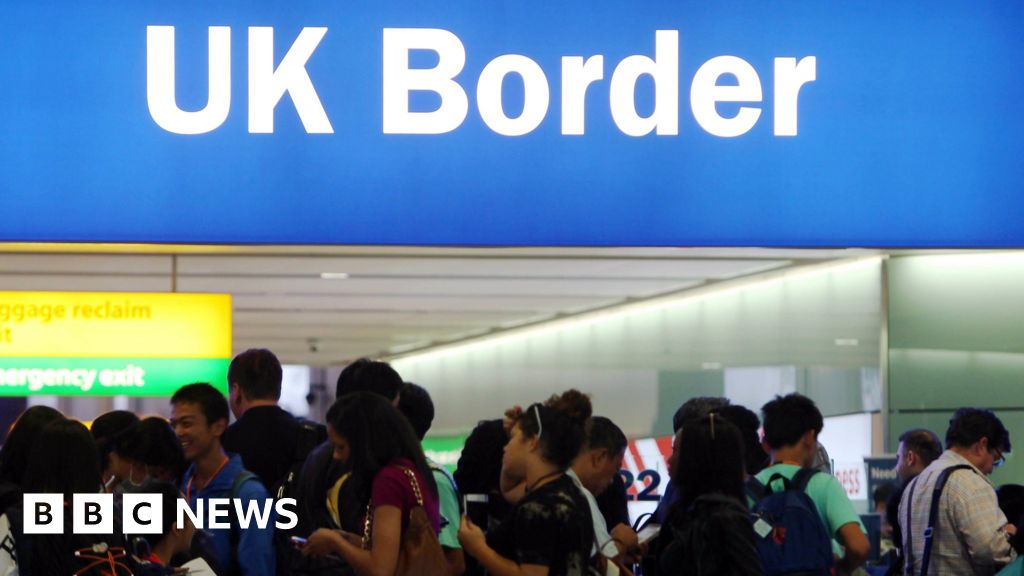Image source, Getty Images
Net migration to the UK fell more than 10% in 2023, according to official figures.
After a record number of people came to the UK in 2022, the government sharply increased salary requirements for visas, to try to cut numbers.
How many migrants come to the UK?
Just over 1.2 million people came to the UK expecting to stay at least a year, and around 532,000 departed.
That’s a fall from 2022’s record net migration figure, which has been revised upwards to 764,000.
However, the ONS said it was “too early to say if this is the start of a new downward trend”.
Of the 1,218,000 who came to the UK in 2023, 10% (126,000) were EU nationals. This is similar to the 2022 total of 116,000.
About 85% (1,031,000) came from outside the EU. The top five non-EU nationalities were:
- Indian – 250,000
- Nigerian – 141,000
- Chinese – 90,000
- Pakistani – 83,000
- Zimbabwean – 36,000
The ONS says approximately 62,000 more Pakistani nationals, 127,000 more Nigerian nationals and 178,000 more Indian nationals came to the UK in 2023 compared with 2019.
The number of people coming to the UK for humanitarian reasons in 2023 – including from Ukraine and Hong Kong – was 50,000, compared to 160,000 in 2022.
How are the minimum salary rules for UK visa applicants changing?
Applicants have to earn at least £38,700 – an increase of nearly 50% from the previous £26,200 minimum.
The threshold does not apply to some jobs – such as in health and social care, and teachers on national pay scales. But overseas care workers can no longer bring family dependants with them.
At the time, groups including the CBI and the Royal College of Nursing criticised the government for failing to address the UK’s labour shortages.
What are the rules about family visas?
You can apply to live with your:
- spouse or partner
- fiancé, fiancée or proposed civil partner
- child
- parent
- relative who will provide long-term care for you
You have to demonstrate a good knowledge of English, and meet the minimum income threshold.
This was initially due to rise to £38,700 – a sharp increase from the previous £18,600 figure.
Anyone renewing an existing family visa will not have to meet the new earnings threshold, the Home Office has confirmed.
Are fewer people coming to work in health and social care?
It said 2,200 health and care worker visas and 6,400 visas for their dependents were granted in April.
The total number of visas granted during the first four months of the year showed a 76% fall compared with the same period in 2023.
The number of dependents’ visas for care workers dropped by 6% over the same period.
How does the points-based system work?
The remaining 20 points can come from a higher salary, working in a sector with job shortages, or having a relevant PhD.
The standard fee for a skilled visa is usually between £719 and £1,500.
The amount can vary – but since April 2024, the standard fee has been £1,035 per year, up from £624.
What is the immigration salary list?
It helps employers fill vacancies in key sectors.
These jobs have a lower salary threshold, making it easier for applicants to gain enough points to get a visa.
Image source, Getty Images
Employers used to be able to pay foreign workers 80% of the usual “going rate” to fill these positions.
But this rule has been abolished for people applying after 4 April 2024.
What are the rules for student and graduate visas?
Of these, 116,000 were issued to Indian nationals, and 109,000 to Chinese nationals.
Those on postgraduate courses could also apply for visas for qualifying dependants: a husband, wife, civil or unmarried partner and children under 18.
In the year to March 2024, 111,000 visas were issued to student dependants, a fall of 25%.
Between January and April 2024, Home Office data shows only 8,300 student dependent visas were issued – a fall of 79%.
Students who have already completed their degree can stay in the UK for two years – three years for those with a doctoral degree – to work under a graduate visa.
In the year to the end of March 2024, 35,000 such visas were issued, excluding dependants, a 38% drop.
What about seasonal workers?
Image source, Getty Images
An application costs £298.
How has Brexit changed immigration?
Before Brexit, EU and UK citizens had the freedom to live, work or study in any EU country without needing a visa.
However, this freedom of movement ended on 1 January 2021 when the UK left the EU.
In the 12 months to June 2023, net EU migration was -86,000, meaning more EU nationals left the UK than arrived.
Net migration of non-EU nationals – the difference between those arriving and those leaving – was 768,000.
Net migration of British nationals was -10,000, meaning more British people left the UK than came back.

